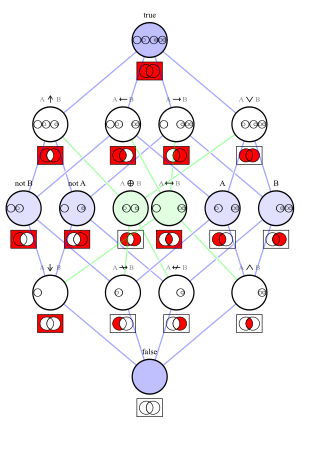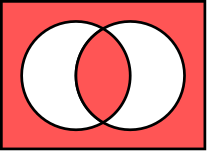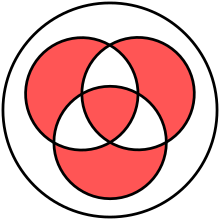In propositional logic, biconditional introduction is a valid rule of inference. It allows for one to infer a biconditional from two conditional statements. The rule makes it possible to introduce a biconditional statement into a logical proof. If is true, and if is true, then one may infer that is true. For example, from the statements "if I'm breathing, then I'm alive" and "if I'm alive, then I'm breathing", it can be inferred that "I'm breathing if and only if I'm alive". Biconditional introduction is the converse of biconditional elimination. The rule can be stated formally as:
Biconditional elimination is the name of two valid rules of inference of propositional logic. It allows for one to infer a conditional from a biconditional. If is true, then one may infer that is true, and also that is true. For example, if it's true that I'm breathing if and only if I'm alive, then it's true that if I'm breathing, I'm alive; likewise, it's true that if I'm alive, I'm breathing. The rules can be stated formally as:
In logic and related fields such as mathematics and philosophy, "if and only if" is paraphrased by the biconditional, a logical connective between statements. The biconditional is true in two cases, where either both statements are true or both are false. The connective is biconditional, and can be likened to the standard material conditional combined with its reverse ("if"); hence the name. The result is that the truth of either one of the connected statements requires the truth of the other, though it is controversial whether the connective thus defined is properly rendered by the English "if and only if"—with its pre-existing meaning. For example, P if and only if Q means that P is true whenever Q is true, and the only case in which P is true is if Q is also true, whereas in the case of P if Q, there could be other scenarios where P is true and Q is false.

In logic, a logical connective is a logical constant. Connectives can be used to connect logical formulas. For instance in the syntax of propositional logic, the binary connective can be used to join the two atomic formulas and , rendering the complex formula .
The propositional calculus is a branch of logic. It is also called propositional logic, statement logic, sentential calculus, sentential logic, or sometimes zeroth-order logic. It deals with propositions and relations between propositions, including the construction of arguments based on them. Compound propositions are formed by connecting propositions by logical connectives representing the truth functions of conjunction, disjunction, implication, equivalence, and negation. Some sources include other connectives, as in the table below.
In propositional logic, modus ponens, also known as modus ponendo ponens, implication elimination, or affirming the antecedent, is a deductive argument form and rule of inference. It can be summarized as "P implies Q.P is true. Therefore, Q must also be true."
In mathematics and logic, a vacuous truth is a conditional or universal statement that is true because the antecedent cannot be satisfied. It is sometimes said that a statement is vacuously true because it does not really say anything. For example, the statement "all cell phones in the room are turned off" will be true when no cell phones are present in the room. In this case, the statement "all cell phones in the room are turned on" would also be vacuously true, as would the conjunction of the two: "all cell phones in the room are turned on and turned off", which would otherwise be incoherent and false.
Intuitionistic logic, sometimes more generally called constructive logic, refers to systems of symbolic logic that differ from the systems used for classical logic by more closely mirroring the notion of constructive proof. In particular, systems of intuitionistic logic do not assume the law of the excluded middle and double negation elimination, which are fundamental inference rules in classical logic.
In logic and mathematics, statements and are said to be logically equivalent if they have the same truth value in every model. The logical equivalence of and is sometimes expressed as , , , or , depending on the notation being used. However, these symbols are also used for material equivalence, so proper interpretation would depend on the context. Logical equivalence is different from material equivalence, although the two concepts are intrinsically related.
In propositional logic, material implication is a valid rule of replacement that allows for a conditional statement to be replaced by a disjunction in which the antecedent is negated. The rule states that P implies Q is logically equivalent to not- or and that either form can replace the other in logical proofs. In other words, if is true, then must also be true, while if is not true, then cannot be true either; additionally, when is not true, may be either true or false.
In propositional logic, double negation is the theorem that states that "If a statement is true, then it is not the case that the statement is not true." This is expressed by saying that a proposition A is logically equivalent to not (not-A), or by the formula A ≡ ~(~A) where the sign ≡ expresses logical equivalence and the sign ~ expresses negation.
In logic, a truth function is a function that accepts truth values as input and produces a unique truth value as output. In other words: the input and output of a truth function are all truth values; a truth function will always output exactly one truth value, and inputting the same truth value(s) will always output the same truth value. The typical example is in propositional logic, wherein a compound statement is constructed using individual statements connected by logical connectives; if the truth value of the compound statement is entirely determined by the truth value(s) of the constituent statement(s), the compound statement is called a truth function, and any logical connectives used are said to be truth functional.

The material conditional is an operation commonly used in logic. When the conditional symbol is interpreted as material implication, a formula is true unless is true and is false. Material implication can also be characterized inferentially by modus ponens, modus tollens, conditional proof, and classical reductio ad absurdum.
In propositional logic, transposition is a valid rule of replacement that permits one to switch the antecedent with the consequent of a conditional statement in a logical proof if they are also both negated. It is the inference from the truth of "A implies B" to the truth of "Not-B implies not-A", and conversely. It is very closely related to the rule of inference modus tollens. It is the rule that
In logic, a functionally complete set of logical connectives or Boolean operators is one that can be used to express all possible truth tables by combining members of the set into a Boolean expression. A well-known complete set of connectives is { AND, NOT }. Each of the singleton sets { NAND } and { NOR } is functionally complete. However, the set { AND, OR } is incomplete, due to its inability to express NOT.
In logic and mathematics, contraposition refers to the inference of going from a conditional statement into its logically equivalent contrapositive, and an associated proof method known as proof by contraposition. The contrapositive of a statement has its antecedent and consequent inverted and flipped.
In mathematics and philosophy, Łukasiewicz logic is a non-classical, many-valued logic. It was originally defined in the early 20th century by Jan Łukasiewicz as a three-valued modal logic; it was later generalized to n-valued as well as infinitely-many-valued (ℵ0-valued) variants, both propositional and first order. The ℵ0-valued version was published in 1930 by Łukasiewicz and Alfred Tarski; consequently it is sometimes called the Łukasiewicz–Tarski logic. It belongs to the classes of t-norm fuzzy logics and substructural logics.
T-norm fuzzy logics are a family of non-classical logics, informally delimited by having a semantics that takes the real unit interval [0, 1] for the system of truth values and functions called t-norms for permissible interpretations of conjunction. They are mainly used in applied fuzzy logic and fuzzy set theory as a theoretical basis for approximate reasoning.
Exportation is a valid rule of replacement in propositional logic. The rule allows conditional statements having conjunctive antecedents to be replaced by statements having conditional consequents and vice versa in logical proofs. It is the rule that:



























































![x
1
-
[?]
-
x
n
{\displaystyle ~x_{1}\leftrightarrow \cdots \leftrightarrow x_{n}}
meant as equivalent to
!
(
!
x
1
[?]
[?]
[?]
!
x
n
)
{\displaystyle \neg ~(\neg x_{1}\oplus \cdots \oplus \neg x_{n})}
The central Venn diagram below,
and line (ABC ) in this matrix
represent the same operation. Variadic logical XAND.svg](http://upload.wikimedia.org/wikipedia/commons/thumb/e/ef/Variadic_logical_XAND.svg/220px-Variadic_logical_XAND.svg.png)


![x
1
-
[?]
-
x
n
{\displaystyle ~x_{1}\leftrightarrow \cdots \leftrightarrow x_{n}}
meant as shorthand for
(
x
1
[?]
[?]
[?]
x
n
)
{\displaystyle (~x_{1}\land \cdots \land x_{n}~)}
[?]
(
!
x
1
[?]
[?]
[?]
!
x
n
)
{\displaystyle \lor ~(\neg x_{1}\land \cdots \land \neg x_{n})}
The Venn diagram directly below,
and line (ABC ) in this matrix
represent the same operation. Variadic logical all or nothing.svg](http://upload.wikimedia.org/wikipedia/commons/thumb/d/d9/Variadic_logical_all_or_nothing.svg/220px-Variadic_logical_all_or_nothing.svg.png)















































